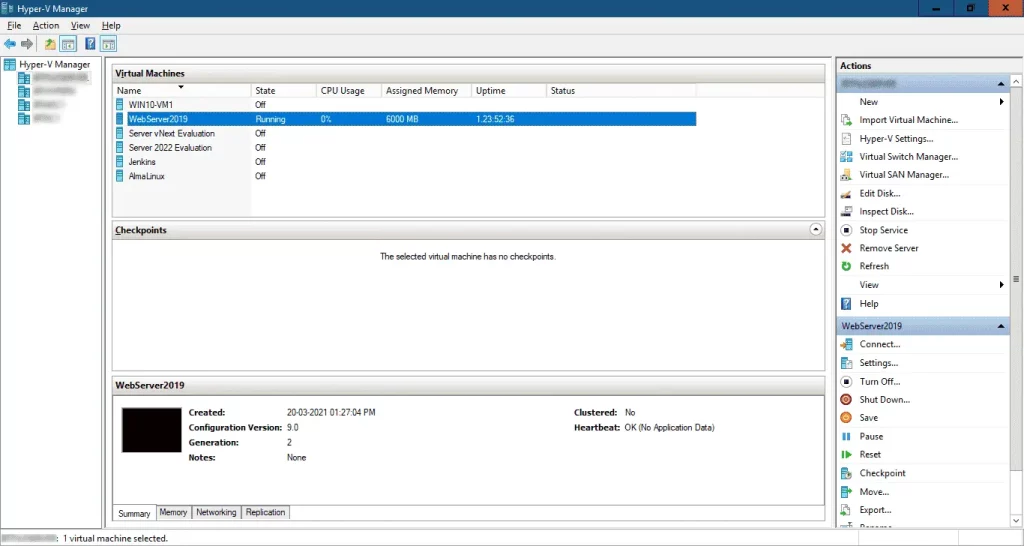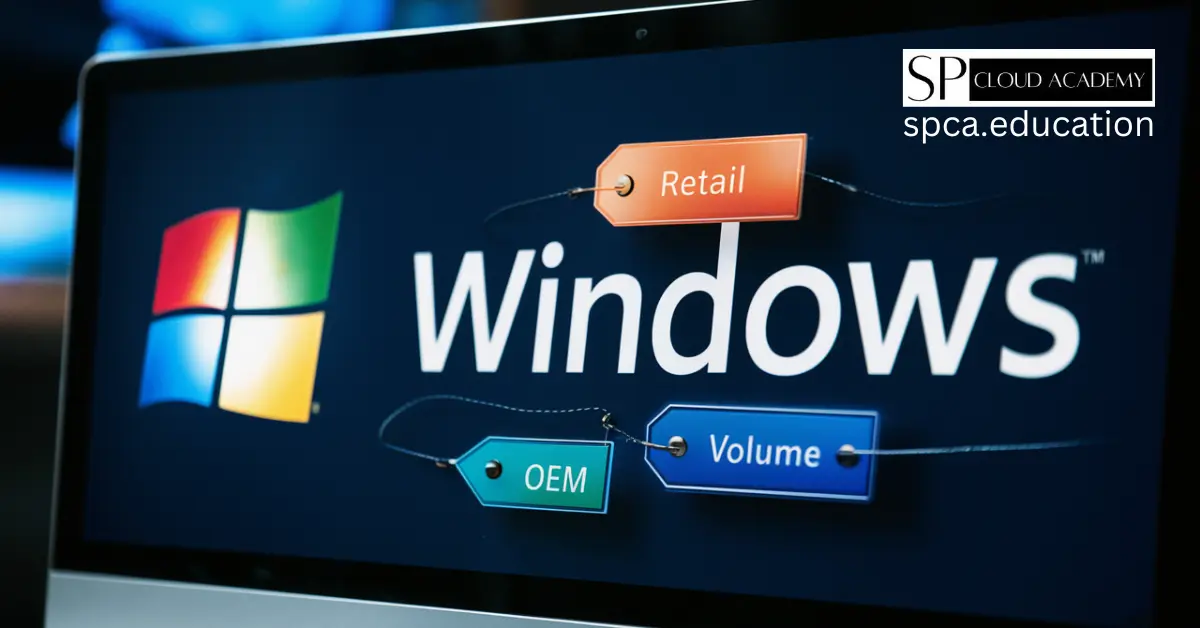Microsoft Hyper-V is a virtualization platform developed by Microsoft. It allows you to create and manage virtual machines (VMs) on a Windows-based system. Hyper-V enables you to run multiple operating systems and applications on a single physical machine, effectively consolidating hardware resources and improving resource utilization.
Key features and concepts of Microsoft Hyper-V include:
- Hypervisor: Hyper-V includes a Type 1 hypervisor, which is a layer of software that directly runs on the physical hardware and manages the virtualized environments.
- Virtual Machines: Hyper-V allows you to create and run multiple virtual machines on a single physical host. Each VM acts as an independent computer, with its own operating system and applications.
- Integration Services: Integration Services are a set of drivers and tools that enhance the performance and interaction between the host system and virtual machines. They provide features like mouse integration, time synchronization, and improved network and storage performance.
- Hyper-V Manager: This is the graphical user interface (GUI) tool used to manage and configure virtual machines, virtual networks, and other Hyper-V components.
- Virtual Switch: Hyper-V provides virtual networking capabilities through virtual switches. These switches allow virtual machines to communicate with each other and with the host system, as well as connect to external networks.
- Live Migration: Hyper-V supports the ability to move running virtual machines from one physical host to another with minimal downtime. This is useful for load balancing, hardware maintenance, and disaster recovery.
- Snapshot and Checkpoint: You can take snapshots or checkpoints of a virtual machine’s state at a specific point in time. This allows you to revert to a previous state if needed.
- Dynamic Memory: Hyper-V can allocate memory dynamically to virtual machines based on their workload, allowing for more efficient memory utilization.
- Resource Metering: Hyper-V allows you to track resource usage by individual virtual machines, helping with capacity planning and monitoring.
- Hyper-V Replica: This feature enables you to replicate virtual machines from one Hyper-V host to another, providing disaster recovery options.
Hyper-V is available in different editions of Windows Server, and there’s also a standalone version called Hyper-V Server, which is a free, stripped-down version of Windows Server designed specifically for hosting virtual machines. Hyper-V is widely used in enterprise environments for server virtualization, development and testing, and creating isolated environments for different applications and scenarios.
Hyper-V versions
- Hyper-V for Windows Servers
Hyper-V is a feature or role available in certain editions of the Windows Server operating system, starting from Windows Server 2008. When you install the Hyper-V role on a Windows Server machine, you’re essentially enabling that machine to act as a hypervisor, which allows you to create and manage virtual machines (VMs).
- Hyper-V Servers
Microsoft Hyper-V Server is a standalone hypervisor-based virtualization platform offered by Microsoft. It allows you to create and manage virtual machines (VMs) on a single physical server, enabling you to run multiple operating systems and applications on a single hardware platform. Hyper-V Server is designed for organizations or individuals seeking a dedicated virtualization solution without the additional features and roles found in a full Windows Server operating system.
Key features and aspects of Microsoft Hyper-V Server include:
- Hypervisor Platform: Hyper-V Server operates as a bare-metal hypervisor, which means it runs directly on the physical hardware without the need for a host operating system. This setup enhances performance and resource utilization.
- Virtualization: Hyper-V Server enables you to create and manage virtual machines, allowing you to consolidate multiple workloads on a single physical server.
- Free Offering: Hyper-V Server is available as a free download from Microsoft. This makes it a cost-effective option for organizations looking to leverage virtualization without the licensing costs associated with full Windows Server editions.
- Remote Management: You can manage Hyper-V Server remotely using tools like Hyper-V Manager from a Windows client machine. This allows you to create, configure, and control virtual machines across the network.
- Support for Windows and Linux VMs: Hyper-V Server supports running both Windows and Linux virtual machines, offering flexibility for various workloads and applications.
- Limited Additional Roles: Unlike full Windows Server installations, Hyper-V Server does not support additional roles such as Active Directory, File Services, or other server roles. It’s primarily focused on virtualization.
- Virtualization Technology: Hyper-V Server employs the same virtualization technology as Hyper-V roles in Windows Server editions. This includes features like live migration, snapshots, replication, and more.
- Automation and Scripting: Hyper-V Server includes a command-line interface (CLI) that allows for scripting and automation of management tasks.
Hyper-V Server is suitable for a range of scenarios, including development and testing, server consolidation, virtual desktop infrastructure (VDI), and creating isolated environments for applications.
- Hyper-V on Windows 10/11
Hyper-V is a feature in Windows 10 and Windows 11 Pro, Enterprise, and Education editions that allows you to create and manage virtual machines (VMs) on your desktop or laptop computer. It enables you to run multiple operating systems and applications on a single physical machine.
Minimum Requirements of Microsoft Hyper-V
The minimum requirements for Microsoft Hyper-V vary depending on the version of the Windows operating system you are using. Hyper-V is a virtualization platform that allows you to create and manage virtual machines on Windows systems.
Here are the general minimum requirements for Hyper-V on Windows Server and Windows 10/11:
For Hyper-V on Windows Server:
- Processor: 64-bit processor with Second Level Address Translation (SLAT).
- RAM: Minimum of 2 GB of RAM, but more is recommended for better performance.
- Disk Space: At least 32 GB of available hard disk space for the installation.
- Networking: A network adapter that supports minimum 1 Gbps throughput is recommended.
- Virtualization Support: Your CPU must support hardware virtualization (Intel VT-x or AMD-V).
- Operating System: Windows Server with Hyper-V role installed.
For Hyper-V on Windows 10/11:
- Processor: 64-bit processor with Second Level Address Translation (SLAT).
- RAM: Minimum of 4 GB of RAM, but more is recommended for better performance.
- Disk Space: At least 64 GB of available hard disk space for the installation.
- Networking: A network adapter that supports minimum 1 Gbps throughput is recommended.
- Virtualization Support: Your CPU must support hardware virtualization (Intel VT-x or AMD-V).
- Operating System: Windows 10 Pro, Enterprise, or Education (for Windows 10) / Windows 11 Pro, Enterprise, or Education (for Windows 11).
It’s important to note that these are just the minimum requirements, and actual performance may vary based on factors such as the number of virtual machines you plan to run, their resource requirements, and the workload you intend to use on them.
For the most up-to-date and detailed information about Hyper-V requirements, I recommend checking the official Microsoft documentation or the relevant resources for your current version of Windows.
Install and Configure Hyper-V on windows client OS
Hyper-V is available on Windows 10/11 Pro, Enterprise, and Education editions. If you have one of these editions, you can follow these steps to install and configure Hyper-V on your Windows 10/11 machine:
Please note that the user interface and options might have evolved, so I recommend checking the official Microsoft documentation or your current Windows 10/11 version for any updates or changes.
- Check System Requirements:
Before you begin, ensure that your computer meets the hardware requirements for running Hyper-V, including hardware-assisted virtualization support (Intel VT-x or AMD-V) in the BIOS/UEFI settings. Check if your system is compatible with Hyper-V. You can do this by opening the System Information window (press Windows key + R, type msinfo32, and press Enter) and scrolling down to the “System Summary” section. If you see the Hyper-V Requirements line and it says “Yes”, then your system is compatible. - Enable Hyper-V Feature:
To install Hyper-V, follow these steps: a. Right-click on the Start button and select “Apps and Features” or “Programs and Features” (depending on your Windows 10 version). b. In the left sidebar, click on “Programs and Features.” c. In the “Programs and Features” window, click on “Turn Windows features on or off.” d. Scroll down and check the box next to “Hyper-V.” Also, you might want to select “Hyper-V Management Tools” to ensure you have the necessary management tools installed. e. Click “OK” and let Windows enable the feature. Your computer might need to restart. - Configure Hyper-V Settings (Optional):
Once Hyper-V is enabled, you can adjust some settings: a. Search for “Hyper-V Manager” in the Start menu and open it. b. In Hyper-V Manager, click on “Hyper-V Manager” in the top-left corner. c. Click on “Hyper-V Settings.” d. Here you can configure options such as the default locations for virtual hard disks and virtual machines, as well as network settings. Adjust these settings as needed. - Create and Configure Virtual Machines:
Now that Hyper-V is installed and configured, you can start creating and configuring virtual machines: a. In Hyper-V Manager, right-click on your host machine and select “New” > “Virtual Machine.” b. The New Virtual Machine Wizard will guide you through creating a new VM. You’ll need to specify things like the amount of memory, virtual hard disk settings, and how you’ll install the operating system (e.g., from an ISO file). c. Follow the prompts to complete the wizard and create the virtual machine. - Install Operating System:
Once the VM is created, start it and install the desired operating system, just as you would on a physical machine. - Manage Virtual Machines:
You can use Hyper-V Manager to manage your virtual machines, including starting, stopping, connecting to them, and adjusting their settings.

Install and Configure Hyper-V on windows server 2019
Installing and configuring Hyper-V on Windows Server 2019 is a straightforward process. Here’s a step-by-step guide:
- Check System Requirements:
Before you start, make sure your server hardware supports virtualization technology and that it’s enabled in the BIOS/UEFI settings. - Install Hyper-V Role: a. Log in to your Windows Server 2019 machine with administrative privileges. b. Open Server Manager. You can find it on the taskbar or search for it in the Start menu. c. In Server Manager, click on Manage in the top-right corner and select Add Roles and Features. d. The Add Roles and Features Wizard will open. Click Next. e. Select Role-based or feature-based installation and click Next. f. Choose your target server (likely the local server) and click Next. g. Scroll down and find Hyper-V in the list. Check the box next to it. h. A dialog will appear, asking if you want to add features required for Hyper-V. Click Add Features. i. Click Next to review the role’s features, and then click Next again. j. Accept the default installation selections and click Next. k. On the Confirm installation selections page, click Install. l. Wait for the installation to complete, and then click Close.
- Configure Hyper-V Settings (Optional): a. After the installation is complete, you can launch the Hyper-V Manager from the Start menu or Server Manager. b. In Hyper-V Manager, click on Hyper-V Manager in the top-left corner. c. Click on Hyper-V Settings. d. Here you can configure options like default locations for virtual hard disks and virtual machines, as well as network settings. Adjust these settings if needed.
- Create and Configure Virtual Machines: a. In Hyper-V Manager, right-click on your host server and select New > Virtual Machine. b. Follow the New Virtual Machine Wizard to create the VM, specifying settings such as memory, virtual hard disk, and installation method for the operating system. c. Complete the wizard to create the virtual machine.
- Install Operating System:
Start the VM and install the desired operating system, just as you would on a physical machine. - Manage Virtual Machines:
You can use Hyper-V Manager to manage your virtual machines, including starting, stopping, connecting to them, and adjusting settings.
Learning Sources
- Introduction to Hyper-V on Windows 10
- Hyper-V Server 2019
- Hypervisor and Virtualization – SP Cloud Academy (spca.education)
Microsoft Hyper-V FAQs
Here are some frequently asked questions (FAQs) about Microsoft Hyper-V:
- What is Microsoft Hyper-V?
Microsoft Hyper-V is a virtualization platform that allows you to create and manage virtual machines on Windows servers and desktops. It enables you to run multiple operating systems and applications on a single physical machine. - How does Hyper-V work?
Hyper-V works by utilizing the hardware virtualization features of modern CPUs to create and manage virtual machines. It provides a hypervisor that sits between the physical hardware and the virtual machines, enabling efficient sharing of resources. - What are the different editions of Hyper-V?
Hyper-V comes in different editions, including Hyper-V Server (a standalone free version), and Hyper-V roles within various editions of Windows Server, such as Standard, Datacenter, and Essentials. - What are the system requirements for Hyper-V?
The system requirements for Hyper-V depend on the version of Windows you’re using. Generally, you need a 64-bit processor with virtualization support, sufficient RAM, available storage space, and compatible hardware. Refer to Microsoft’s official documentation for specific requirements. - How do I install Hyper-V?
Hyper-V can be installed as a role on Windows Server editions or as a feature on Windows 10/11 Pro, Enterprise, or Education editions. You can use the “Add Roles and Features” wizard in Server Manager or the “Turn Windows features on or off” settings in Windows to install Hyper-V. - What is a virtual machine in Hyper-V?
A virtual machine (VM) in Hyper-V is a software-based emulation of a physical computer. It runs an operating system and applications just like a physical machine, but multiple VMs can share the resources of a single physical host. - What is live migration in Hyper-V?
Live migration is a feature in Hyper-V that allows you to move a running virtual machine from one physical host to another without causing downtime for the VM. This is useful for load balancing, maintenance, and high availability scenarios. - Can I run Linux on Hyper-V?
Yes, Hyper-V provides support for running various Linux distributions as guest VMs. Microsoft has improved Linux compatibility over the years, making it possible to run Linux workloads alongside Windows VMs. - What is Hyper-V Manager?
Hyper-V Manager is a graphical tool that allows you to create, configure, and manage virtual machines and their resources. It provides an interface to perform tasks such as creating VMs, adjusting settings, and connecting to VM consoles. - Is Hyper-V secure?
Hyper-V provides isolation between virtual machines, helping to enhance security. However, like any software, security depends on proper configuration and updates. It’s important to follow best practices and keep both the host OS and guest VMs up to date. - Is Hyper-V free?
Yes, Hyper-V Server is a standalone free product that provides virtualization capabilities. Hyper-V roles in Windows Server editions and Hyper-V features in Windows 10/11 Pro, Enterprise, or Education editions are included with their respective licenses.
These are just a few common questions about Microsoft Hyper-V. If you have more specific queries or need detailed information, it’s recommended to refer to the official Microsoft documentation or seek assistance from experts familiar with Hyper-V.
See Also
-

Why Software-Defined Networking Is the Future (And What That Means for You)
-

From Hardware to Apps: Mastering Every Type of Virtualization in Cloud Computing
-

The Ultimate Guide to the Best Open Source Identity and Access Management Solutions
-

Windows License Types Explained: Retail vs OEM vs Volume — Which One’s Right for You?
-

Secure Boot Demystified: What It Is and Why It’s Your PC’s First Line of Defense
-

Legacy BIOS Is Dying — Here’s Why UEFI & Secure Boot Are Taking Over
